-
 Bitcoin
Bitcoin $84,398.9646
0.76% -
 Ethereum
Ethereum $1,869.1926
-0.36% -
 Tether USDt
Tether USDt $0.9998
-0.04% -
 XRP
XRP $2.1086
-0.70% -
 BNB
BNB $604.6731
-1.42% -
 Solana
Solana $124.7454
-3.24% -
 USDC
USDC $0.9998
-0.06% -
 Dogecoin
Dogecoin $0.1697
-1.97% -
 Cardano
Cardano $0.6711
-0.95% -
 TRON
TRON $0.2356
0.32% -
 Toncoin
Toncoin $4.0118
-2.80% -
 Chainlink
Chainlink $13.4245
-3.82% -
 UNUS SED LEO
UNUS SED LEO $9.3691
1.70% -
 Stellar
Stellar $0.2659
-1.31% -
 Avalanche
Avalanche $19.0943
-1.86% -
 Sui
Sui $2.3597
-0.41% -
 Shiba Inu
Shiba Inu $0.0...01227
-4.71% -
 Hedera
Hedera $0.1651
-1.72% -
 Polkadot
Polkadot $4.0774
-2.53% -
 Litecoin
Litecoin $81.8132
-3.83% -
 MANTRA
MANTRA $6.2052
-1.64% -
 Bitcoin Cash
Bitcoin Cash $303.6704
-2.64% -
 Bitget Token
Bitget Token $4.5807
-1.88% -
 Dai
Dai $1.0001
0.00% -
 Ethena USDe
Ethena USDe $0.9997
-0.02% -
 Pi
Pi $0.6743
-6.00% -
 Hyperliquid
Hyperliquid $13.2193
-4.35% -
 Monero
Monero $214.6905
-1.51% -
 Uniswap
Uniswap $6.0882
-1.58% -
 Aptos
Aptos $5.2686
-1.87%
How is the difficulty of mining adjusted?
Bitcoin's difficulty adjustment, recalculated every 2016 blocks, ensures stable block times by responding to changes in network hash rate and miner participation.
Apr 01, 2025 at 07:14 am
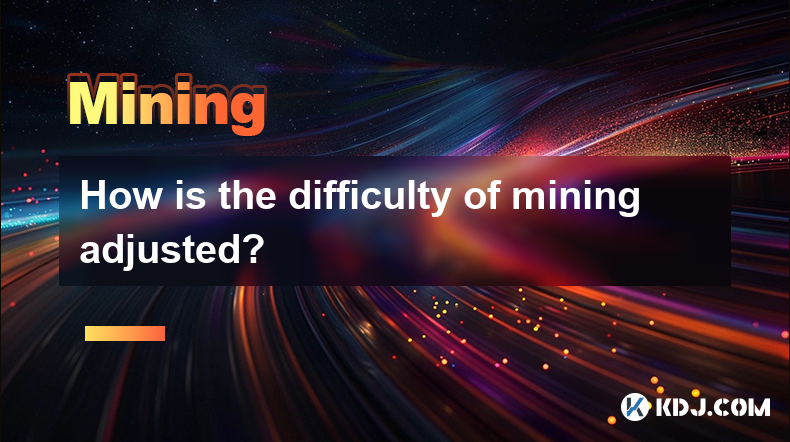
Understanding Bitcoin's Difficulty Adjustment Mechanism
Bitcoin's mining difficulty is a crucial element ensuring the network's stability and security. It dynamically adjusts to maintain a consistent block generation time, approximately every 10 minutes. This adjustment prevents miners with overwhelming computing power from monopolizing block creation and ensures the network remains decentralized. The difficulty is represented as a numerical value; a higher value means it's harder to mine a block.
The Retargeting Algorithm: How it Works
The difficulty retargeting algorithm is the core mechanism behind this dynamic adjustment. It's a formula that recalculates the difficulty every 2016 blocks. This roughly equates to a two-week period. The algorithm analyzes the time taken to mine the previous 2016 blocks. If it took less than the target time (approximately 10 minutes/block * 2016 blocks = 20160 minutes), the difficulty increases. Conversely, if it took longer, the difficulty decreases.
The Mathematical Formula Behind the Adjustment
The exact formula is complex, but it essentially involves comparing the actual time taken to mine the last 2016 blocks with the target time. The ratio of these times is then used to adjust the difficulty. This ensures that the network automatically corrects for fluctuations in the total hash rate (the combined computing power of all miners). The adjustment is proportional; a significant deviation from the target time leads to a proportionally significant difficulty adjustment.
Factors Influencing Difficulty Adjustment
Several factors can influence the time it takes to mine 2016 blocks, and consequently, the difficulty adjustment. These include:
- The total hash rate of the network: A higher hash rate means blocks are mined faster, leading to an increased difficulty. A lower hash rate results in a decreased difficulty.
- Miner participation: An increase or decrease in the number of active miners directly affects the network's hash rate.
- Mining hardware advancements: The introduction of more efficient ASICs (Application-Specific Integrated Circuits) can significantly increase the network's hash rate, triggering difficulty adjustments.
- Network congestion: Although less direct, high network congestion can indirectly impact block generation times.
Step-by-Step Illustration of Difficulty Adjustment
Let's illustrate the process with a simplified example:
- The network's target block generation time is 10 minutes.
- The last 2016 blocks were mined in 18,000 minutes (shorter than expected).
- The algorithm calculates the ratio: 18000 minutes / 20160 minutes = 0.89
- The difficulty is then adjusted proportionally based on this ratio. The new difficulty will be higher than the previous one.
- If the last 2016 blocks were mined in 22000 minutes (longer than expected), the ratio would be greater than 1, resulting in a difficulty decrease.
Why is Difficulty Adjustment Crucial?
The difficulty adjustment mechanism is essential for maintaining the stability and security of the Bitcoin network. Without it:
- Miners with significantly more computing power could control block creation. This would centralize the network, undermining its core principles of decentralization.
- Block generation times could become erratic. Unpredictable block times would negatively impact transaction confirmations and network reliability.
- The network's security could be compromised. A centralized network would be more vulnerable to attacks and manipulation.
The Impact of Hash Rate on Difficulty
The hash rate is a critical factor influencing the difficulty adjustment. A sudden surge in the hash rate, perhaps due to the introduction of new, more powerful mining hardware, will result in a rapid increase in the difficulty. Conversely, a decline in the hash rate, possibly caused by a decrease in miner participation or an increase in electricity costs, will lead to a reduction in difficulty. This dynamic interplay ensures the network adapts to changes in mining capacity.
Difficulty Adjustment and Network Security
The difficulty adjustment is intrinsically linked to the security of the Bitcoin network. A higher difficulty makes it more computationally expensive for attackers to attempt a 51% attack, where they control more than half of the network's hash rate. This inherent self-regulation contributes significantly to the long-term security and resilience of the blockchain. The system's ability to adapt to changes in mining power is a crucial component of its robust design.
Predicting Future Difficulty Adjustments
While the difficulty adjustment algorithm is deterministic, predicting future adjustments with absolute precision is challenging. The algorithm depends on the unpredictable collective behavior of miners, advancements in mining hardware, and fluctuations in the price of Bitcoin, all of which influence the network's hash rate. While historical data can provide insights, unforeseen events can significantly impact the difficulty adjustment.
Frequently Asked Questions
Q: How often is the Bitcoin mining difficulty adjusted?
A: The Bitcoin mining difficulty is adjusted approximately every two weeks, or after every 2016 blocks are mined.
Q: What happens if the mining difficulty becomes too high?
A: If the difficulty becomes too high, it means it takes longer to mine blocks. This can lead to slower transaction confirmations, but it also makes the network more secure against attacks. Miners with less powerful hardware might become less profitable.
Q: What happens if the mining difficulty becomes too low?
A: If the difficulty is too low, blocks are mined too quickly. This could potentially compromise the network's security and make it easier for attackers to launch a 51% attack.
Q: Can the difficulty adjustment be manipulated?
A: No, the difficulty adjustment is a deterministic algorithm based on the time taken to mine the previous 2016 blocks. It cannot be manipulated by any single entity or group. Any attempt to artificially influence the block generation time would be quickly countered by the automatic adjustment.
Q: How does the difficulty adjustment affect the profitability of mining?
A: The difficulty adjustment directly impacts mining profitability. A higher difficulty reduces the profitability of mining because it takes more computational power and energy to mine a block, while a lower difficulty increases profitability. Miners constantly evaluate the profitability of their operations based on the current difficulty and the price of Bitcoin.
Disclaimer:info@kdj.com
The information provided is not trading advice. kdj.com does not assume any responsibility for any investments made based on the information provided in this article. Cryptocurrencies are highly volatile and it is highly recommended that you invest with caution after thorough research!
If you believe that the content used on this website infringes your copyright, please contact us immediately (info@kdj.com) and we will delete it promptly.
- MEXC Clears the Air on Kaspa Controversy – Here's Why the Community Shouldn't Be Worried
- 2025-04-02 16:35:12
- 9GAG Has Reportedly Taken Control of Hong Kong-listed Howkingtech
- 2025-04-02 16:35:12
- KOR Protocol, a well-known blockchain-based platform revolutionizing entertainment industry and intellectual property management, has announced an exclusive launch.
- 2025-04-02 16:30:12
- Amid the market's ongoing recovery, Floki Inu (FLOKI) forms a bullish price action pattern
- 2025-04-02 16:30:12
- Stables, the blockchain-powered fantasy horse racing game, expands into North America
- 2025-04-02 16:25:12
- XRP Price Stalled After Failing to Break Above the $2.20 Resistance Zone
- 2025-04-02 16:25:12
Related knowledge
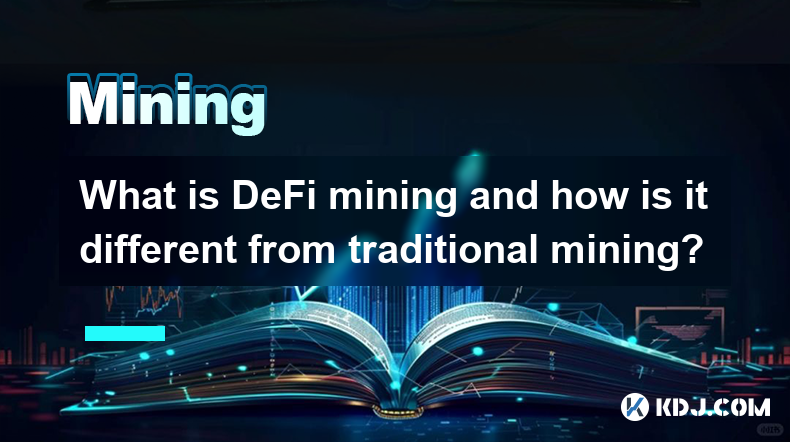
What is DeFi mining and how is it different from traditional mining?
Apr 02,2025 at 09:50am
DeFi mining, also known as yield farming or liquidity mining, is a process within the decentralized finance (DeFi) ecosystem where users provide liquidity to decentralized platforms in exchange for rewards. Unlike traditional mining, which involves solving complex mathematical problems to validate transactions and add them to a blockchain, DeFi mining f...
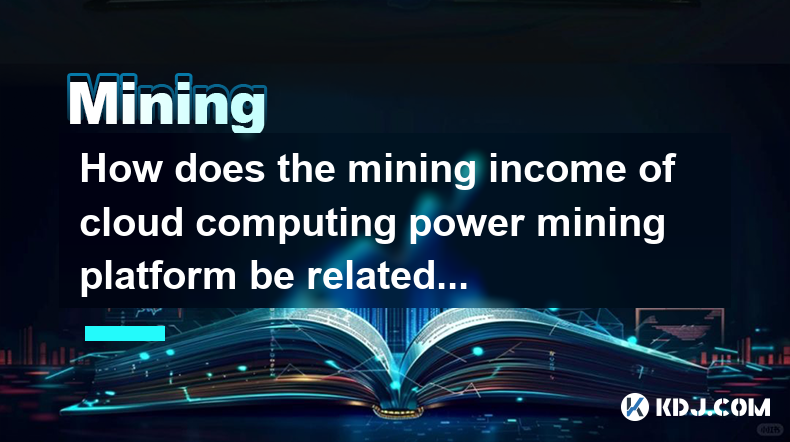
How does the mining income of cloud computing power mining platform be related to mining pool allocation?
Apr 02,2025 at 01:56am
The relationship between the mining income of a cloud computing power mining platform and the allocation of mining pools is a crucial aspect of cryptocurrency mining. Mining income is influenced by various factors such as the efficiency of the mining hardware, electricity costs, and the specific cryptocurrency being mined. However, the allocation of min...
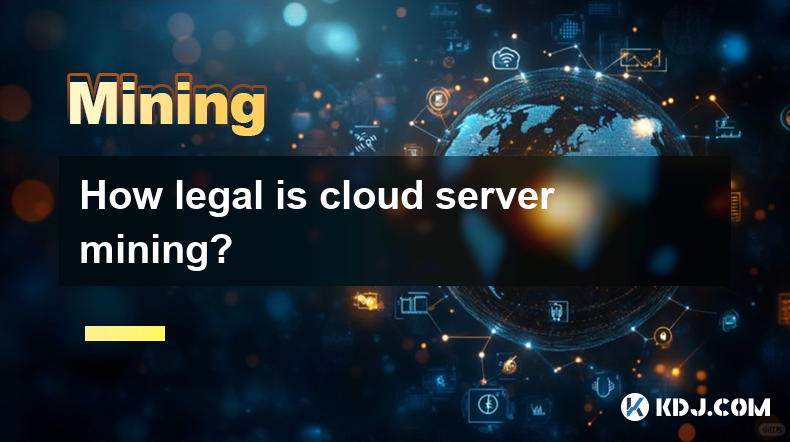
How legal is cloud server mining?
Apr 01,2025 at 08:08am
Cloud server mining has become an increasingly popular method for individuals and companies to participate in cryptocurrency mining without the need for expensive hardware and high electricity costs. However, the legality of cloud server mining can be a complex issue, as it varies by jurisdiction and depends on several factors. This article will explore...
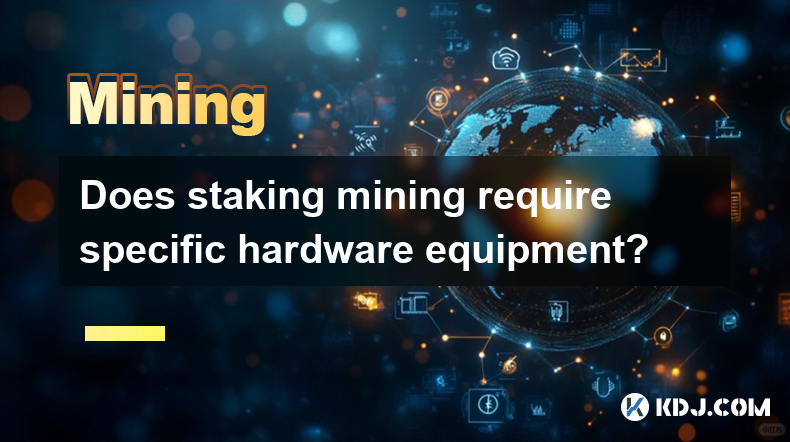
Does staking mining require specific hardware equipment?
Apr 02,2025 at 08:21am
Staking mining, often referred to simply as staking, is a process used by various cryptocurrencies to secure their networks and validate transactions. Unlike traditional mining, which often requires specialized hardware like ASICs (Application-Specific Integrated Circuits) or high-performance GPUs (Graphics Processing Units), staking typically does not ...
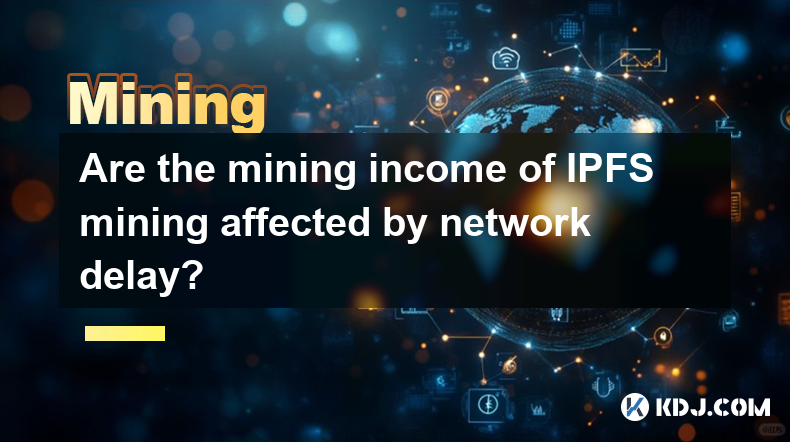
Are the mining income of IPFS mining affected by network delay?
Apr 01,2025 at 09:36pm
Are the Mining Incomes of IPFS Mining Affected by Network Delay? Understanding IPFS Mining and Network Delay's ImpactIPFS (InterPlanetary File System) mining, unlike Bitcoin mining, doesn't involve solving complex cryptographic puzzles. Instead, it focuses on providing storage and bandwidth to the network. Miners earn rewards for storing and sharing dat...
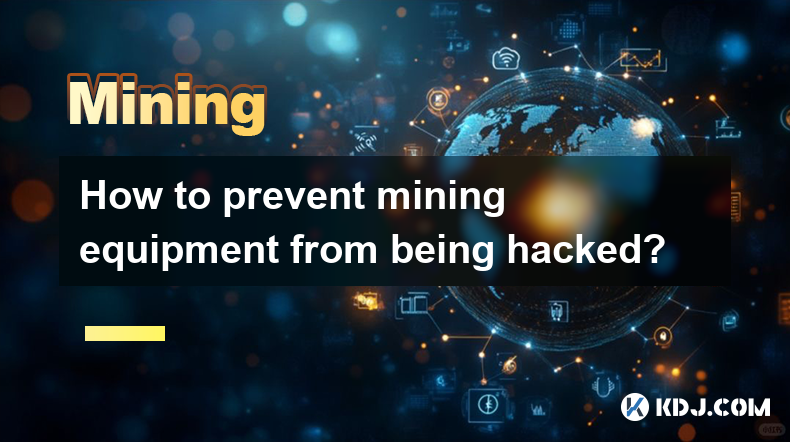
How to prevent mining equipment from being hacked?
Apr 01,2025 at 06:22am
Understanding the ThreatsCryptocurrency mining, while potentially lucrative, exposes your equipment to various cyber threats. These threats range from simple malware infections that steal your mining profits to sophisticated attacks that hijack your entire operation. Understanding these threats is the first step in effective protection. This includes r...

What is DeFi mining and how is it different from traditional mining?
Apr 02,2025 at 09:50am
DeFi mining, also known as yield farming or liquidity mining, is a process within the decentralized finance (DeFi) ecosystem where users provide liquidity to decentralized platforms in exchange for rewards. Unlike traditional mining, which involves solving complex mathematical problems to validate transactions and add them to a blockchain, DeFi mining f...

How does the mining income of cloud computing power mining platform be related to mining pool allocation?
Apr 02,2025 at 01:56am
The relationship between the mining income of a cloud computing power mining platform and the allocation of mining pools is a crucial aspect of cryptocurrency mining. Mining income is influenced by various factors such as the efficiency of the mining hardware, electricity costs, and the specific cryptocurrency being mined. However, the allocation of min...

How legal is cloud server mining?
Apr 01,2025 at 08:08am
Cloud server mining has become an increasingly popular method for individuals and companies to participate in cryptocurrency mining without the need for expensive hardware and high electricity costs. However, the legality of cloud server mining can be a complex issue, as it varies by jurisdiction and depends on several factors. This article will explore...

Does staking mining require specific hardware equipment?
Apr 02,2025 at 08:21am
Staking mining, often referred to simply as staking, is a process used by various cryptocurrencies to secure their networks and validate transactions. Unlike traditional mining, which often requires specialized hardware like ASICs (Application-Specific Integrated Circuits) or high-performance GPUs (Graphics Processing Units), staking typically does not ...

Are the mining income of IPFS mining affected by network delay?
Apr 01,2025 at 09:36pm
Are the Mining Incomes of IPFS Mining Affected by Network Delay? Understanding IPFS Mining and Network Delay's ImpactIPFS (InterPlanetary File System) mining, unlike Bitcoin mining, doesn't involve solving complex cryptographic puzzles. Instead, it focuses on providing storage and bandwidth to the network. Miners earn rewards for storing and sharing dat...

How to prevent mining equipment from being hacked?
Apr 01,2025 at 06:22am
Understanding the ThreatsCryptocurrency mining, while potentially lucrative, exposes your equipment to various cyber threats. These threats range from simple malware infections that steal your mining profits to sophisticated attacks that hijack your entire operation. Understanding these threats is the first step in effective protection. This includes r...
See all articles

























































































